AMD Announces Carrizo and Carrizo-L, Next Gen APUs for H1 2015
by Ian Cutress on November 20, 2014 5:45 PM EST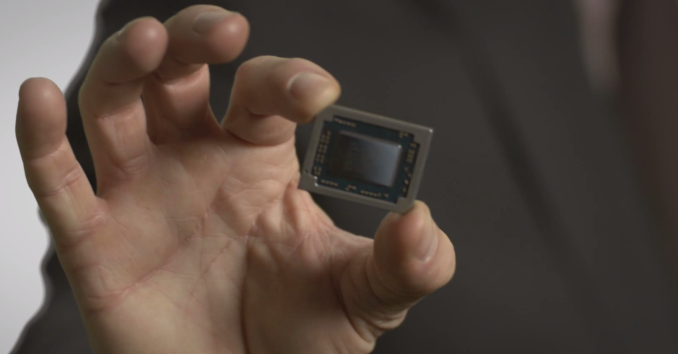
Today AMD is announcing the long anticipated upgrade to Kaveri, codenamed Carrizo. Carrizo is the natural successor to Kaveri, featuring x86 ‘Excavator’ cores alongside a Radeon-class GPU and promising an increase in performance all around. The second part of today’s announcement is for Carrizo-L, an SoC pairing “Puma+” (upgraded Beema) cores also with AMD’s R-series GCN GPUs and a FCH into a single package. Both Carrizo and Carrizo-L will feature ARM Trustzone, giving potential hardware-based built-in security when used by developers.
The Excavator cores are an architectural improvement over Steamroller, but are fundamentally based on the original Bulldozer concept. Excavator will be AMD’s fourth iteration of the concept, following Bulldozer, Piledriver and Steamroller. This new generation of APUs are still set to be built on the 28nm Super High Performance process at Global Foundries, delaying AMD’s shift to 20nm, but AMD are still claiming that the new GPU in Carrizo is their best yet, giving better performance and efficiency than before.
Given AMD's discrete GPU lineup, the GPU for Carrizo could be based on AMD's latest GCN 1.2 architecture, which was first introduced in the desktop Tonga part earlier this year. GCN 1.2's lossless delta color compression algorithms help improve the performance in memory bandwidth limited scenarios, such as in APUs. This could result in a bigger-than-expected jump in performance, although we will wait until we can test to find out how much it helps.
The Carrizo platform will be fully HSA 1.0 compliant, compared to Kaveri which only had ‘HSA Features’, as AMD puts it in their latest mobility roadmap update:
The push from AMD into HSA compliant APUs was well documented back at the launch of Kaveri earlier this year. This enabled the CPU and GPU components of the silicon, while under OpenCL 2.0 mode, to have access to the main block of system DRAM with zero-time copy functions, offering the potential for large classes of applications especially those in the prosumer and industry space to be accelerated by having instant access to the parallelization afforded by the GCN GPU. One of the big drawbacks of being an earlier adopter to HSA, as we noted at the time, was that software developers required time to bring their code to market, as well as AMD having to go out and teach the developers how to cater for HSA topology.
Both Carrizo and Carrizo-L on the mobile side will be targeted at the same power bands as Kaveri and Beema, although the socket will be new. The use of FP4 BGA also indicates that a single socket will cater for both the Excavator and Puma+ based APUs and would be interchangeable. A video by AMD’s VP/GM for Computing and Graphics, John Byrne, states that Carrizo and Carrizo-L are currently being tested internally ready for a 1H 2015 release, along with support for DirectX 12, OpenCL 2.0, Mantle and Freesync.
One of the big features that AMD is pushing with Carrizo is energy efficiency, with it being a keystone of the message. Because AMD have been on the same process node for a short while, they have to essentially follow the Maxwell example, by providing more performance for less power without the advantage of shrinking resistors. We were provided with an energy efficiency roadmap as well, showing the different methods AMD is using to achieve this:
One example of the efficiency improvement was provided by AMD’s Voltage Adaptive Operation. Rather than compensate for voltage variations which wastes energy, this technology takes the average operating voltage and detects when the voltage increases beyond a smaller margin. To compensate for this increase, the CPU speed is reduced until the voltage drops below the threshold and then the CPU speed is moved back up.
The changes in speed are designed to be so minute that it does not affect overall performance, however it might only take an errant voltage delivery component to consistently make the voltage go above that threshold, causing erratic slowdown that might be statistically significant. It will be interesting to see how AMD implements the latest version of this feature.
The 2015 desktop roadmap remains unpublished so far. AMD’s perception of a mobile-focused strategy would tend to suggest that the mobile comes first, with desktop following behind, although at this point it is unclear. A number of AMD’s marketing materials with this launch gave examples of the use of Carrizo and HSA for the prosumer, indicating that a desktop version should be announced in due course.
As of yet there was no discussion on the APUs to be launched, the speeds or the capabilities. All the roadmap tells us is 'up to four cores' (Excavator for Carrizo, Puma+ for Carrizo-L), some GCN compute units and 10-45W overall. There is no mention of DDR4 support, although the timeframe might be relevant for AMD to make the jump. Given the launch is still at least two quarters away, I would expect better details in due course. That timeframe fits in nicely around or just after Computex, perhaps indicating more details then.
Source: AMD


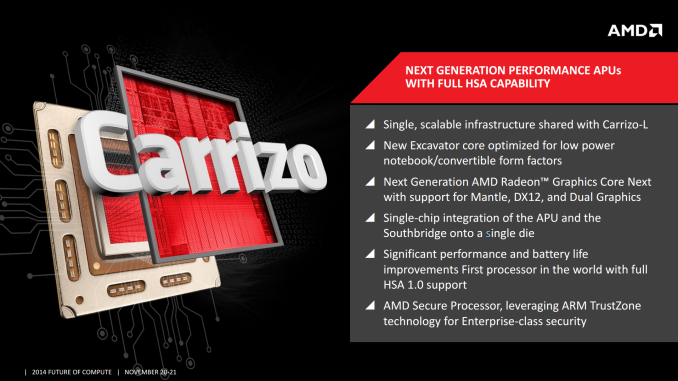
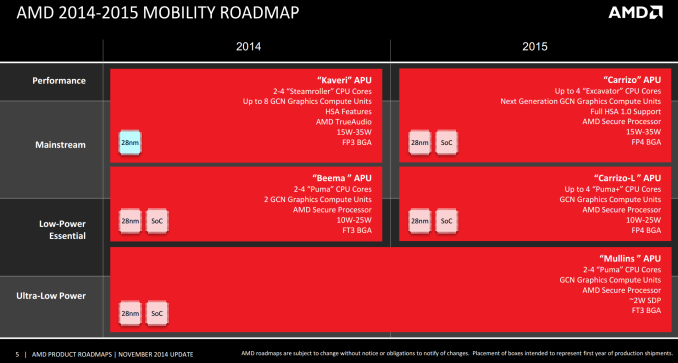
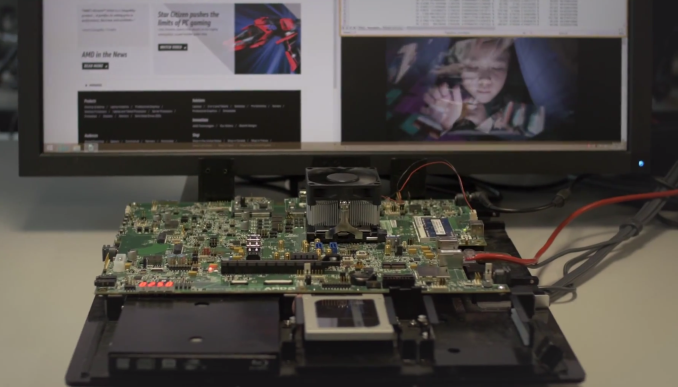
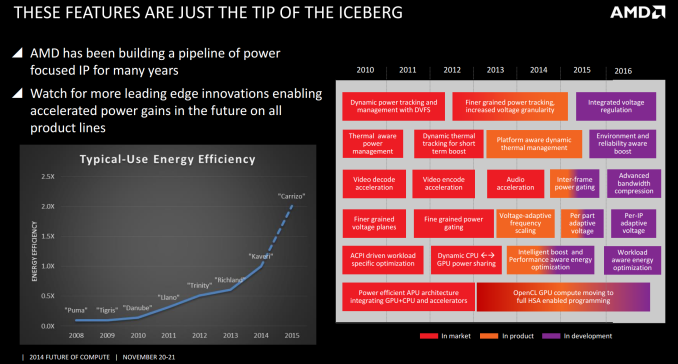
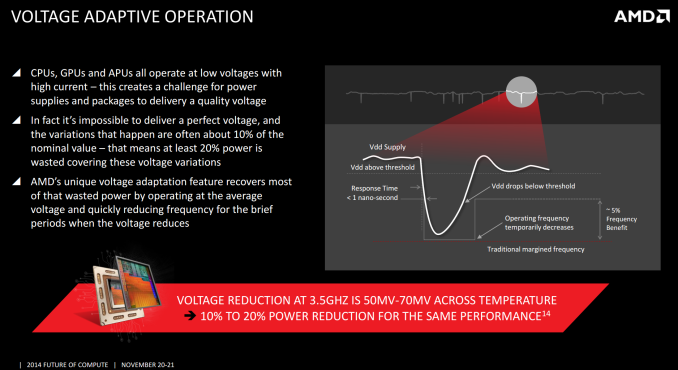
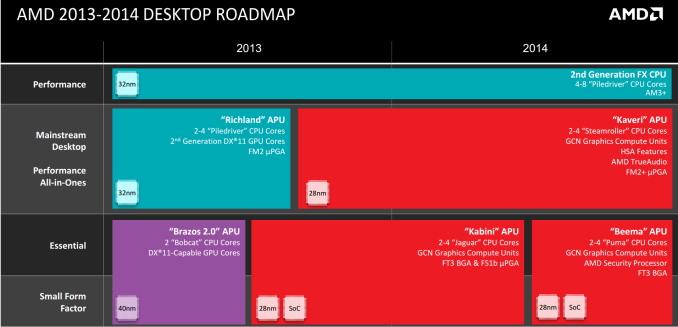








94 Comments
View All Comments
DigitalFreak - Friday, November 21, 2014 - link
It's a city in ArizonaJlHADJOE - Friday, November 21, 2014 - link
For a couple of weeks I actually thought it was "Chorizo".mikato - Monday, November 24, 2014 - link
Carrizon Plain - https://www.google.com/search?q=carrizo+plain&...mikato - Monday, November 24, 2014 - link
ugh, wish I could edit.Carrizo Plain
zodiacfml - Friday, November 21, 2014 - link
I'm not touching an AMD mobile APU. Though the A4-1250 APU is the slowest, it shouldn't be slower than a dual core Intel Atom. I thought it was Windows 8.1 and installed W7, but no, internet browsing is still a painful experience. The APU is capable is of FULL HD video decoding but the CPU sucks so much that its not watchable.Masospaghetti - Friday, November 21, 2014 - link
Sounds great and all, but I still can't even get a FX-7600p / FX-7500 / A10-7400p mobile APU despite being "released" six months ago. As much as I like AMD, I haven't been too impressed with their performance lately.drexnx - Friday, November 21, 2014 - link
agreed. I've been dying to give AMD business (I had an a6-5200 for a week before returning it, not enough power) and they just can't seem to deliver any products to marketcharliem76 - Friday, November 21, 2014 - link
Pretty much a +1 to the rest of the comments. The form factors that OEMs are putting AMD chips into are afterthoughts. They either need a true partner to deliver the highly desirable form factors or do it themselves. Me? I want a surface pro 3 clone (with the same screen res), and a fanless NUC that can drive 1080 content.r3loaded - Friday, November 21, 2014 - link
I bought the Sandy Bridge 2500K that resides in my desktop system back in early 2011. Wake me up when AMD come up with a CPU that can beat this four year old 32nm chip in single-thread performance without pulling more than its 95W TDP to do so.stmok - Saturday, November 22, 2014 - link
So we need to wait until 2016 before AMD finally abandons Bulldozer-based architecture?